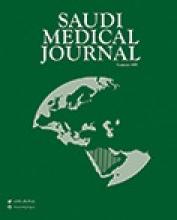Abstract
OBJECTIVES: To test the applicability of the Tanaka and Johnston prediction method in a Saudi population.
METHODS: The current study was conducted at the College of Dentistry, King Saud University, Riyadh, Saudi Arabia from September 2013 to January 2014, on a sample of 409 pairs of orthodontic study models. The mesiodistal width of the mandibular permanent incisors, permanent canines, and permanent premolars were measured using an electronic digital caliper with an accuracy of 0.01mm. The predicted widths derived from the Tanaka and Johnston equation were compared with the actual measured widths.
RESULTS: Gender differences were observed in the sum of the mesiodistal width of canine and premolars in both arches as indicated by t-test (p<0.001). The sum of the actual mesiodistal widths of canines and premolars were compared with the predicted widths derived from the Tanaka and Johnston equation and significant differences were found (p<0.001). The regression analysis indicated that the sum of the mesiodistal width of the mandibular permanent incisors is a good predictor for those of unerupted canines and premolars, with the correlation coefficients ranging from 0.51 to 0.61. Accordingly, 2 linear regression equations were developed for tooth width prediction for Saudi males and females.
CONCLUSION: The Tanaka and Johnston prediction equation overestimated the sum of mesiodistal widths of permanent canines and premolars in Saudis. New regression equations were formulated for the prediction of tooth width in the Saudi population.
- Copyright: © Saudi Medical Journal
This is an open-access article distributed under the terms of the Creative Commons Attribution-Noncommercial-Share Alike 3.0 Unported, which permits unrestricted use, distribution, and reproduction in any medium, provided the original work is properly cited.






